The iPhone 6 Review
by Joshua Ho, Brandon Chester, Chris Heinonen & Ryan Smith on September 30, 2014 8:01 AM EST- Posted in
- Smartphones
- Apple
- Mobile
- iPhone 6
Display
As the primary mode of interaction with the phone, the display is one of the most important areas of evaluation. Of course, the methods of evaluation can be hotly debated. There is a great deal of subjectivity in this area in terms of what someone prefers. However, for the sake of color calibration our tests follow world-wide standards instead of personal preference one way or another. This means that we use the sRGB gamut and 2.2 gamma, which most content is adapted to. While AdobeRGB and other gamuts exist, these are for limited use cases and only applicable to operating systems that are aware of multiple gamuts and can dynamically switch between them depending upon the metadata of the content. In order to accurately test for how well a display conforms to these standards, we use SpectraCal’s CalMAN 5 along with a spectrophotometer for accurate color readings.
For those that are unfamiliar with the display of the iPhone 6 and Apple’s key marketing points on this new model, the improvements are mostly centered on higher resolution, contrast, and better viewing angles. In terms of higher resolution the iPhone 6 moves from the 1136x640 pixels of the iPhone 5/5s generation to 1334x750 pixels. However, this doesn’t improve the pixel density, which remains at 326 pixels per inch.
In practice, I definitely continue to notice the difference in resolution when using the iPhone 6 as opposed to the higher pixel density iPhone 6 Plus and the various Android smartphones with 450+ PPI displays. I definitely don’t find the resolution to be a problem though, as these issues only become significant to me below 300 PPI. I do think that around 450 to 500 PPI is the right place to be when balancing pixel density and power, but Apple’s choice should pay off in the form of better power consumption especially because LED backlights rapidly lose efficiency near the highest current region.
The other issue at hand is that of viewing angles. While Apple is one of the first to really talk about dual domain pixels, this technique is rather commonly used to improve viewing angles. The result is that a pair of pixels will appear to be a chevron, and overall the pixels appear to be squiggly in nature. While this doesn’t really change the readability of the display at extreme angles, colors like white no longer have noticeable red/yellow/blue shifts depending upon the angle that the display is shifted at.
This is definitely noticeable in everyday use, as the iPhone 5s could only avoid color shifting at certain angles instead of every angle. As I predicted in the launch article though, the one caveat seems to be that black has a noticeable shift towards purple in certain angles. There's also a noticeable hatching on close examination, but this doesn't affect image quality. This is definitely better than what I see on AMOLED though, as while AMOLED has much better brightness stability the color shifting is far more obvious and significant.

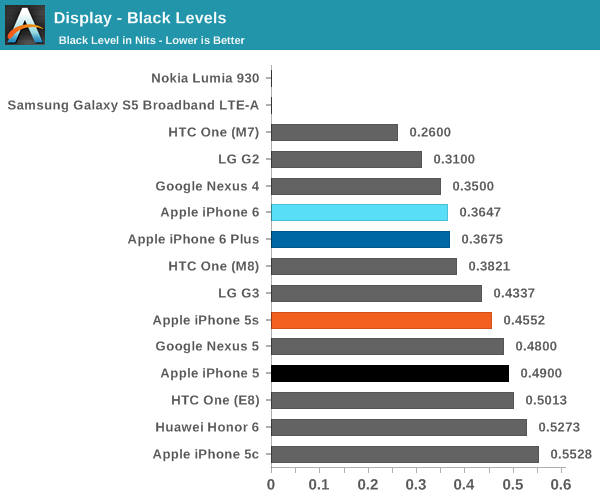

Now that we’ve covered the other two, we can talk about contrast. For this test, we measure brightness of 100% white and black at maximum display brightness, and look at the ratio. While we’re looking into getting patterns that can’t be defeated by dynamic contrast/backlight this should give an idea of best case contrast. In this case, peak brightness is on the high side at 560 nits, with relatively low black brightness at about a third of a nit. The result is one of the best contrast ratios I’ve ever seen. While the HTC One (M7) has a 1743:1 contrast ratio in our tests, some testing I’ve done indicates that the true contrast ratio is realistically around that of the One (M8). I’m not quite sure how this was done, but Apple stated that a new deposition process was used for the liquid crystals. This, along with changes to the liquid crystals themselves, could be responsible for the improved contrast.
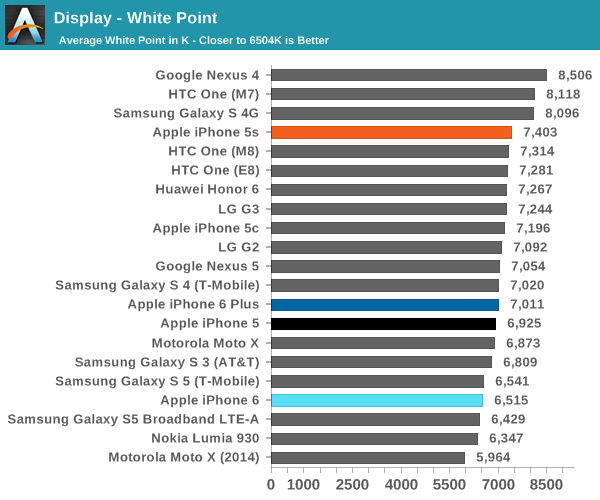
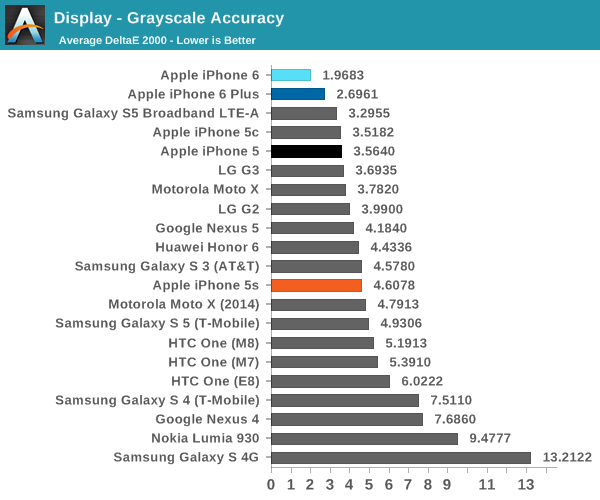
The next part to talk about is grayscale, which is an area where Apple seemed to prefer bluer color balances. I don’t really have much to pick at here, because the level of calibration here is incredible. While there is a noticeable trend of overshooting red at the low end and undershooting red at the high end, this is nitpicking at best. At any rate, this is essentially perfect.
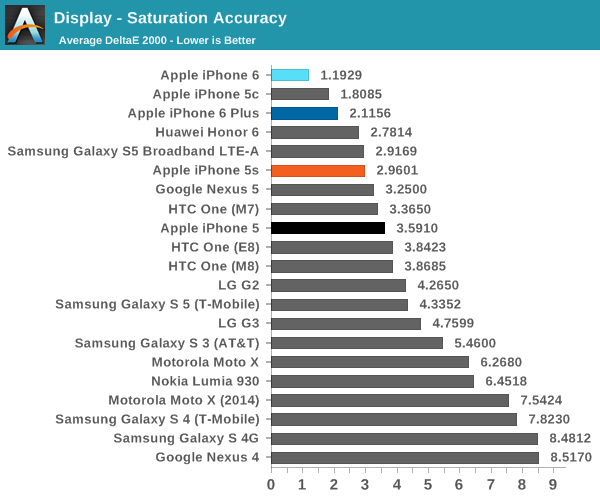
Our next test is the saturation sweep, which tests each primary and secondary color for accuracy in hue and luminance. While it’s true that humans can be relatively insensitive to differences in saturation, it is all too common to see OEMs artificially compress saturations to have vivid colors and be able to claim that they have an accurate display because it matches the sRGB gamut. In this test, the iPhone 6 sets a new record. I really don’t have any objections here because a dE2000 value of 1.19 is a deviation that is almost impossible to notice.
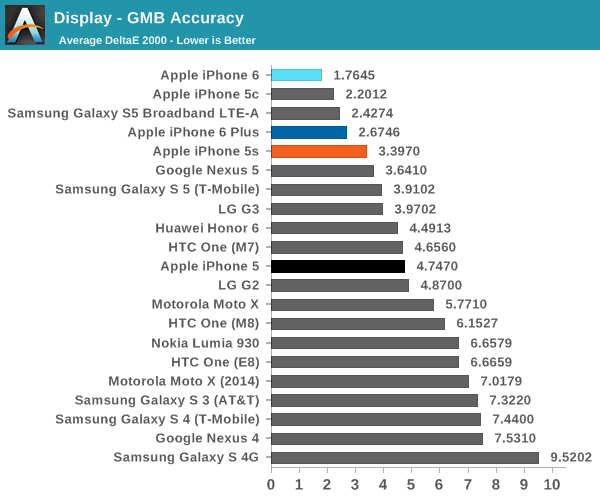
The final test is the Gretag MacBeth ColorChecker, which tests various hues and is usually one of the hardest tests to perform well in. In this regard, the iPhone 6 once again sets a new record for accuracy. This display is effectively calibrated to sRGB, and one would be hard pressed to find a significant deviation when compared to a reference monitor.
Overall, it’s hard to find any criticism for this display. I would normally be incredibly suspicious to see these numbers on a smartphone, but the fact that there’s a hot pixel in the center of the display suggests to me that this was not a cherry-picked unit. The fact that I find this level of calibration to be suspicious speaks volumes about how good this display is. While contrast isn't AMOLED levels of black, there are no purple smearing effects, noticeable uneven luminance near black, or any other idiosyncrasies.


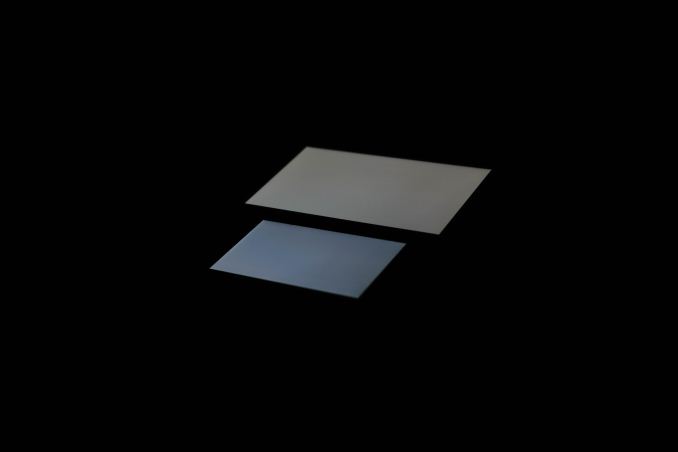
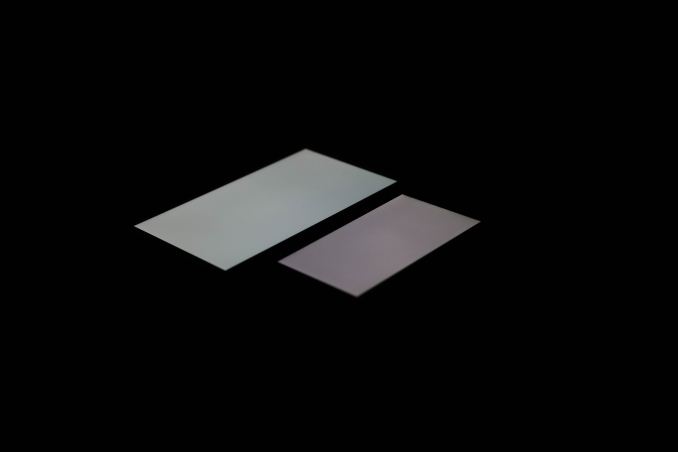
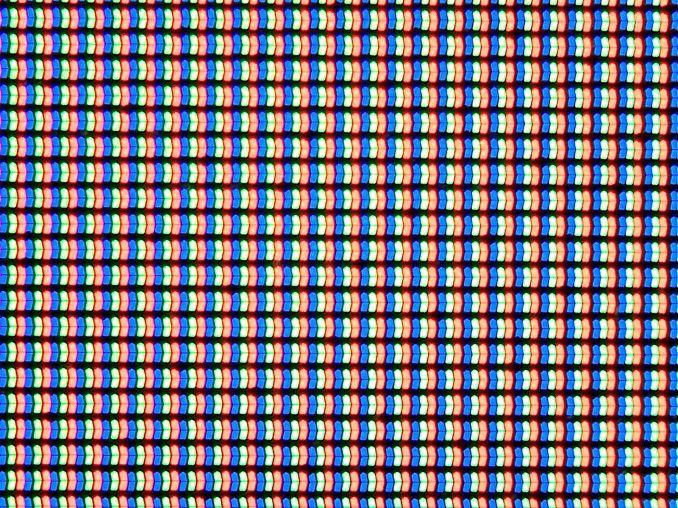

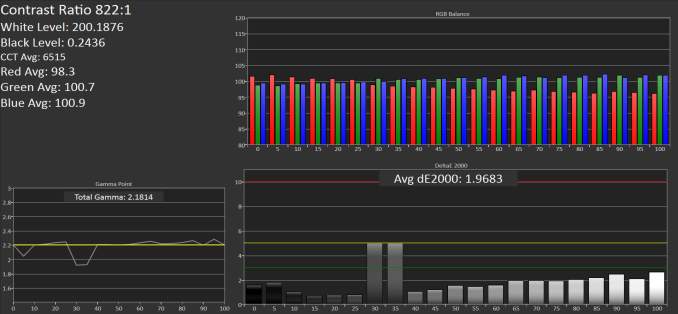

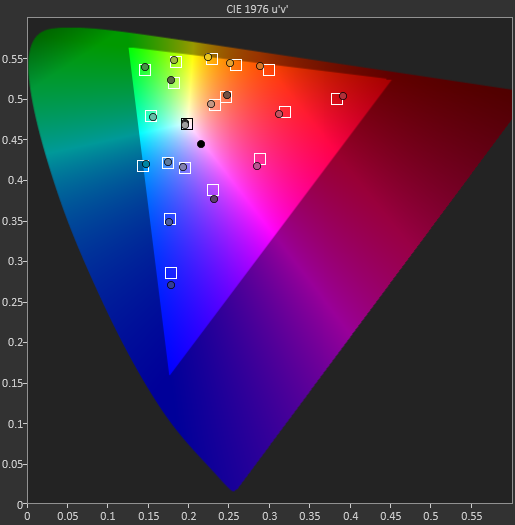








531 Comments
View All Comments
grayson_carr - Tuesday, September 30, 2014 - link
I own an iPad and my wife uses an iPhone. I hate lightning connectors. They're expensive, they die or stop being recognized far too frequently, and I can't use them with any of my other electronics so they add more cable clutter to my house and cars. So your statement is false. There are people who own Apple devices and still hate lightning connectors. Also, check out the lightning cable reviews at Apple's website (1300 1 star reviews vs 130 5 star reviews... hmm)... http://store.apple.com/us/product/MD818ZM/A/lightn...blackcrayon - Tuesday, September 30, 2014 - link
How are people killing these lightning cables? I've never had one die, the first one i got from my iPhone 5 is probably still working (can't tell them apart really, but they're all still working).shm224 - Thursday, October 2, 2014 - link
you are the exception, not the norm. the 1.5 star, out of 5, on Apple review clearly demonstrates that @grayson_carr isn't the only one with unhappy with Apple's charge cables.mrochester - Wednesday, October 1, 2014 - link
It sounds like you're being incredibly careless with your cables. Personally I think people who don't look after their things deserve to see them broken. I've never had any Apple or micro-USB cable break. Maybe try looking after you're stuff a bit better?dmacfour - Wednesday, October 1, 2014 - link
A lot of people think it's normal to bend the connector ends of the cable at obscene angles. I've never done thing with any kind of cable, and I've never had a cable fray.akdj - Friday, October 3, 2014 - link
I agree. We've got a dozen ipad fours. We use them in the field. All over Alaska and from extreme to extreme temperature wise. Had the iPhone 5&5s'es for 17 employees and my wife, nine year old son iPod touch fifth gen and not a SINGLE lightning cable since their release two years ago has crapped out. Two dozen at least with backups for vehicles, desks and homes.This is ridiculous. Whoever 'breaks' a Lightining cable does it intentionally. They don't. Just. Break. Good Lord!
michael2k - Tuesday, September 30, 2014 - link
Apple has more cash on hand than the US Treasury:http://www.bizjournals.com/sanjose/news/2014/04/14...
Not sure why you think they needed to compete in the mid and low end three years ago, do you really think they need that much more cash?
Hemlocke - Tuesday, September 30, 2014 - link
Exactly. Every other OEMS competes there, and the only one who is even playing in the same sport as Apple is Samsung, and they have been sent back to the minors over the last year. Competing on the low-end/price is a race to the bottom that nobody wins except Google, much like Microsoft did in the PC business. In the end, Apple proved that model to be inferior, as well.techconc - Thursday, October 2, 2014 - link
Lightning connector is not defective. We all wish USB would have put nearly as much thought into their connectors as Apple has. I can't exactly blame Apple for raising the bar here and showing others how it should be done.It's funny, people see jacka$$ on youtube putting lots of pressure on an iPhone 6 plus and assume it's a real issue. Those that I know with a 6+ don't seem to have any trouble with it in their pockets, etc. Also, why no mention of devices like the HTC One which bends under considerably less pressure? According to consumer reports, it bends under 70 lbs of pressure whereas the iPhone 6+ doesn't start to bend until 90 lbs. of pressure.
supgk - Tuesday, September 30, 2014 - link
Wow.. I sincerely hope it's just Samsung paying you to write that. The thought that anyone would truly believe it is depressing.